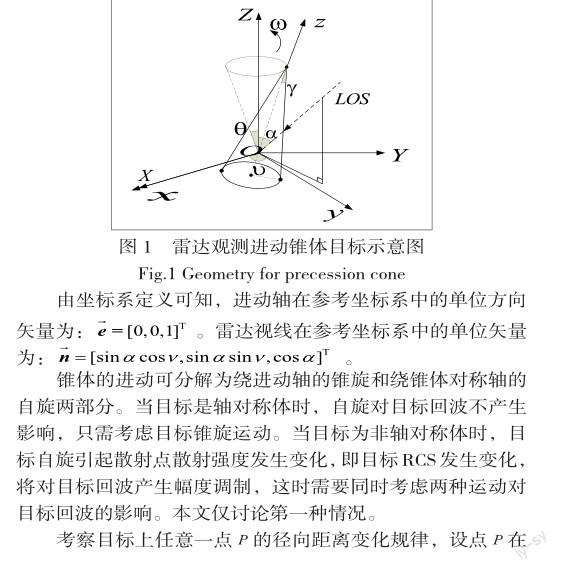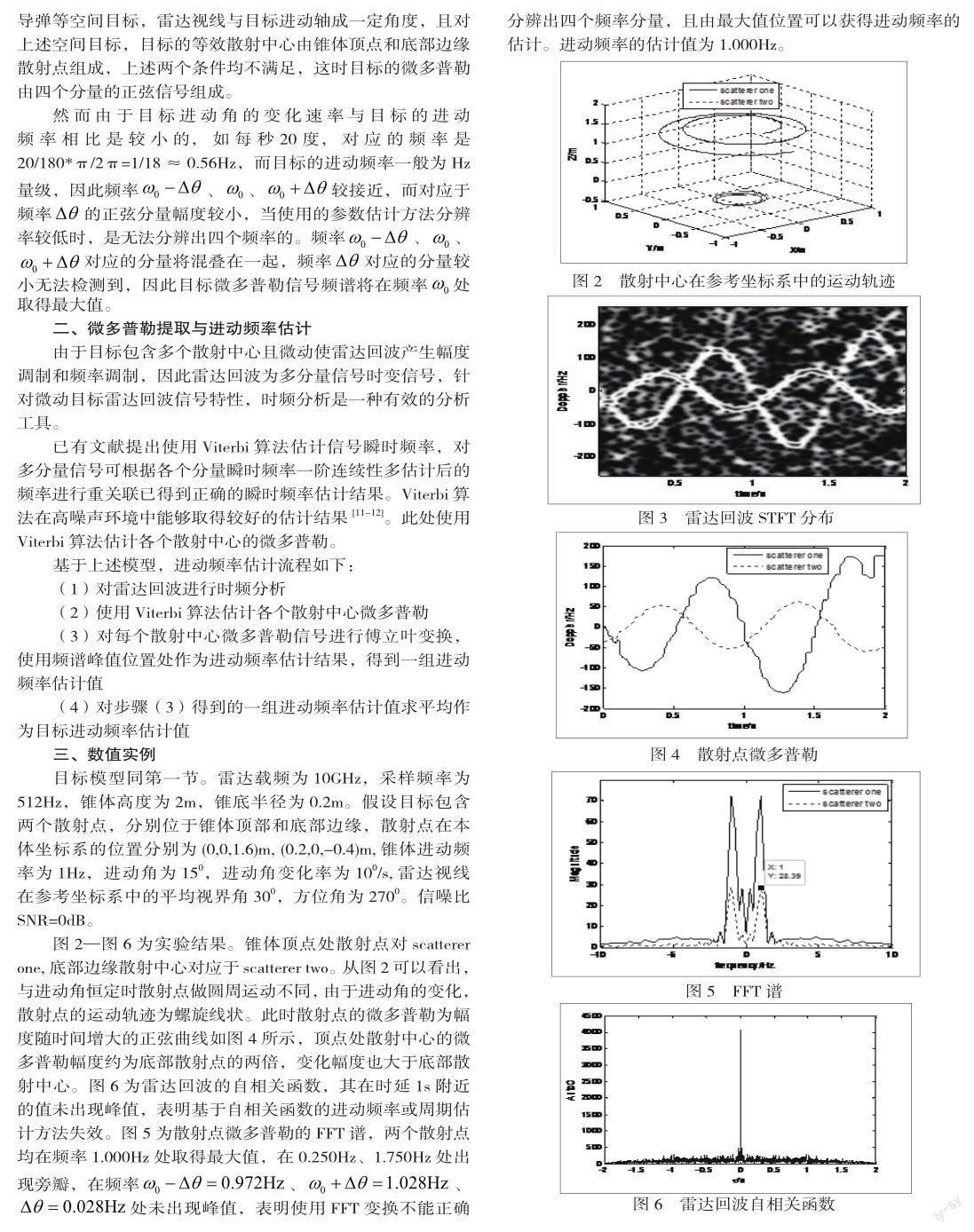時變空間進動目標雷達回波建模及參數估計
劉琨
【摘要】 微動狀態通常獨一無二,反映了目標的精細特征,在目標識別中有重要意義。目前研究多假設目標在雷達視線的投影上做簡諧運動;然而在實際環境中,目標微動參數時變,目標在雷達視線上的投影也更加復雜,導致雷達回波調制形式更加復雜。已建立的模型不再適用。本文建立了一種時變空間進動目標雷達回波模型,分析了其微多普勒調制形式,并在此基礎上估計進動頻率。仿真結果驗證了模型的正確性和估計方法的有效性。
【關鍵詞】 進動 微多普勒 參數估計
Radar model of time-varying precession space target and parameter estimation
Abstract:Micro-motion states which reflect the sophisticated features of targets are always unique; it is of great important for target recognition. Most of the researches are based on that the projection motions of targets along the light sight of radar are sinusoidal; nevertheless, in real environment it is more complicated due to that the micro-motion parameters of targets might be time-varying, leading to more complicated modulation mode of radar returned signals. This paper establishes a model of precession space target undergoing time-varying micro-motion parameters, then the micro-Doppler is analyzed, finally we manage to estimate the precession frequency based on the model. Simulation study has confirmed the correctness of model and effectiveness of our algorithm.
Keywords:precession;micro-Doppler; parameter estimation
引言
微動是指目標或目標的組成部分除了主體平動之外的振動、轉動等小幅運動。目標微動對雷達回波產生調制效應,使得目標的多普勒譜展寬,稱為微多普勒效應[1]。微動特征反映了目標的結構和運動特性,是目標識別的重要依據。由于其獨特性,雷達目標微動特征在目標探測、分類、識別領域中得到了廣泛的應用[3-5]。
已建立的目標微動模型包括剛體和非剛體兩大類。常見的雷達目標微動模型為振動、旋轉、翻滾、進動[1-3,6],行人[7-8]和直升飛機[9]的微動特征也是研究的熱點。除了行人模型外,上述目標模型均假設目標在雷達視線的投影運動為簡諧運動或簡諧運動疊加多項式運動,然而在實際環境中,目標微動參數常常是時變的,目標運動在雷達視線上的投影也更加復雜。如中段彈道目標進動是一種典型的微動現象,與誘餌的運動不同,可作為彈頭識別的依據。然而,中段彈道目標容易受到擾動(如釋放誘餌時的擾動),使進動角發生時變[10]。
微動參數時變導致目標雷達回波不再是簡單的正弦調頻形式,繼續運用已有的模型將會導致微動參數估計錯誤或精度降低,影響目標的有效識別,因此有必要研究時變微動目標。
為了分析微動參數時變情況下目標雷達回波的特性和估計方法,本文建立了進動角漸變情況下空間進動目標雷達回波模型,在此基礎上分析了目標微多普勒的調制形式,并估計進動頻率。
一、時變空間進動目標微多普勒調制模型
1.1 錐體進動模型
文獻[2]推導了微動參數恒定情況下進動錐體目標上任意一點的徑向距離模型,本文在此基礎分析進動角漸變情況下的距離表達式 。
雷達觀測錐體目標如圖1所示,并假設目標符合雷達遠場條件。建立參考坐標系O-XYZ:以目標質心為原點,錐體進動軸為Z軸,錐頂方向為Z軸正向,定義與初始時刻錐體對稱軸共面且垂直于Z軸的方向為Y軸,X軸由右手準則確定。設目標對稱軸與Z軸的夾角即進動角為θ(t)。目標進動角速度為ω,自旋角速度為Ω。設雷達視線在參考坐標系中的方位角為V,雷達視線與進動軸夾角為α,稱為平均視界角。以目標質心O為原點、目標對稱軸為Z建立目標本體坐標系O-xyz。設目標質心距雷達初始距離為R0[2]。


四、結論
本文建立了時變空間進動目標模型,分析了進動角線性變化對目標微多普勒的影響。當進動角變化時,目標的微多普勒形式較為復雜,上述的理論分析與實驗結果表明進動角漸變情況下目標微多普勒不再是標準的正弦信號,出現了幅度調制,是一個多諧波信號,由于進動角變化速率相比進動頻率較小,在進動頻率處的正弦信號為主要成分,對目標微多普勒做傅立葉變換可獲得進動頻率的估計。
參 考 文 獻
[1] Chen V C, Fayin L, Shen-shyang H, et al. Micro-doppler effect in radar: phenomenon, model, and simulation study [J]. IEEE Transactions on Aerospace and Electronic Systems, 2006, 42(1): 2~21.
[2]李康樂. 雷達目標微動特征提取與估計技術研究[D]. 長沙:國防科學技術大學,2010. [Li Kang-le. Research on feature extraction and parameters estimation for radar targets with micro-motions [D]. Changsha: National University of Defense Technology, 2010.]
[3]韓勛, 杜蘭, 劉宏偉, 等. 基于時頻分布的空間錐體目標微動形式分類 [J]. 系統工程與電子技術, 2013, 35(4): 684-691. [Han Xun, Du lan, Liu Hong-Wei, et.al. Classification of micro-motion form of space cone-shaped objects based on time-frequency distribution [J]. Systems Engineering and Electronics, 2013, 35(4): 684-691.]
[4] Yang F, Wang J, Chang L. Research on the life detection based on mirco Doppler features [J]. Advanced Materials Research, 2014, 846: 1153-1156.
[5] Tekeli B, Gurbuz S Z, Yuksel M, et al. Classification of human micro-doppler in a radar network [C]. 2013 IEEE Radar Conference (RADAR), Ottawa, Canada, April 29- May 3, 2013.
[6] Zhao, Y Q , Wang G Z, Bai Y Q, et al. A new method of translational compensation for space spinning target based on EMD [C]. 2013 IEEE International Conference on Signal Processing, Communication and Computing, Kunming, August 5-8, 2013.
[7] FOGLE O R E. Human micro-Range/micro-Doppler signature extraction, association, and statistical characterization for high-resolution radar[D]. Wright State University, 2011.
[8] Karabacak, C, Gurbuz S Z, Gurbuz A C. Radar simulation of human micro-Doppler signature from video motion capture data [C]. Signal Processing and Communications Applications Conference (SIU), 2013 21st, Haspolat, April 24-26, 2013.
[9] Zhang L, Huang G Q. Extracting of micro Doppler parameter of helicopter rotor based on time-frequency analysis [J]. Applied Mechanics and Materials, 2012, 130: 2696-2700.
[10]劉義峰,李明,杜云峰.基于微多普勒分析的彈道目標識別技術研究 [J]. 電子科技, 2010, 23(3):81~83. [Research on the discrimination of the ballistic targets based on micro-Doppler analysis. Electronic Science and Technology [J]. 2010, 23(3):81~83.]
[11] Li P, Wang D C, Wang L. Separation of micro-Doppler signals based on time frequency filter and Viterbi algorithm [J]. Signal, Image and Video Processing, 2013. 7(3): 593-605.
[12] Stankovic L, Djurovic I, Thayaparan T. Micro -Doppler -based target detection and feature extraction in indoor and outdoor environments [J]. Journal of the Franklin Institue, 2008, 1(3):1~23.

